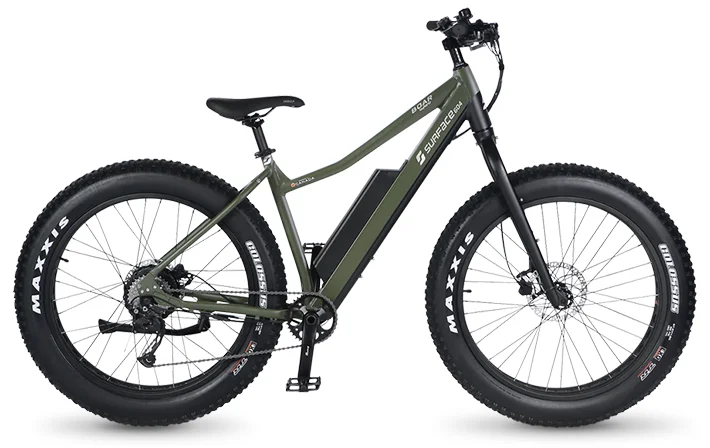Looking around eBikes.org there will be e-bikes that make you wonder just what the heck makes them as expensive as a quality used car. There will be others that seem about right compared to a traditional bicycle at around $1,500 to $2,000, but they might have lower-quality components.
There are two parts of an e-bike that contribute to the final purchase price. Let’s start out by looking at the electric drive system.

Battery, Controller, Sensors, and Motor
You will find different electrical setups on e-bikes, but broadly the electrical system comprises the battery, computer controller, sensors, and motor.
Battery
A premium electric touring and trekking bike like the Riese & Müller Superdelite above has two large batteries in its toptube and downtube, with 1025Wh of power in total. You can get e-bikes that don’t cost nearly $9,000 with similar-sized batteries like the Boar Explorer that we will look at later, because there are different levels of quality when it comes to batteries. The battery system in the Superdelite uses premium cells and has a better battery management system to ensure that the cells last longer.
Torque and Cadence Sensors
Where you can get a 1.25kWh battery in some monster overlanders made in the US, the Superdelite will travel much farther per charge than those hunks of American metal. One of the reasons is that it uses a torque sensor that can measure your pedaling 1000 times a second. This measures the force of your pedaling and delivers just enough motor power (and therefore battery power) to match.
Cheaper electric bikes use a far cheaper cadence sensor that measures how quickly you are pedaling, sometimes as infrequently as one time per second. This translates to far less efficiency from the motor. If you ride two e-bikes with the same motor but one with a torque sensor and the other with a cadence sensor, you’ll immediately feel the performance difference even though they are using the same power system.
Motors
There are two types of motors used on e-bikes – the hub motor and the mid-drive motor. Hub motors are far simpler affairs and in themselves can be one of the longest-lasting components of an e-bike, lasting years after the battery has degraded. They don’t deliver the same riding feel as a mid-drive motor, and move the center of gravity toward the rear of the bike too, making it less agile and comfortable to ride on rougher terrain.
Mid-drive motors, however, can cost well over $1,000 on their own. These sit in the bottom bracket area of the bike and transmit the power through the chain as you naturally do via the pedals. Containing a gearbox of their own, they are more complex affairs. And whereas a hub motor may last 10 years without any maintenance, mid-drives could need servicing every 5,000 miles or so.
Controllers
Behind all these major components is the e-bike’s ‘brain,’ or controller. This is a computer that makes decisions about power delivery based on feeds from the throttle or pedal assist sensor and input from you via the handlebars – for example, via the power setting.
The Superdelite above will have a much higher-quality controller than the next e-bike we will look at below, the Boar Explorer.
The Bike Itself
Boar Explorer
The most expensive part of an e-bike typically is the bicycle on which the electrical system is mounted. The frame, fork, wheels, and pedal drivetrain are variables that will impact the wholesale cost of the machine and ultimately what you will pay for it retail.

The Boar brand’s design team chose to put a rigid fork on the Explorer to reduce the manufacturing cost and therefore be able to sell the e-bike at $2,699. They said that they could have put a cheaper suspension fork but that would have impacted the ride and durability of the bike. If you want to have a suspension fork on it, you can add it as an optional extra for $799, which would take it out of its intended price bracket.
Such design decisions are made across all e-bikes. The Riese & Müller e-bike above uses quality suspension forks on different models, including a few options made by market leaders Fox. You won’t see a Fox fork on a $2,000 e-bike because the fork alone will have a wholesale price in the several hundred dollar range and potentially wipe out the margin to make selling it viable.
One of the extremely expensive options on the Superdelite is the Rohloff Speedhub internal gear hub system. These retail for $820 new. Where these systems are fitted only to the ultra-premium end of the e-bike spectrum, most electric bikes will have a classic derailleur/cassette drivetrain. In the case of the Boar Explorer, this is a modestly priced Shimano drivetrain that might cost $50 wholesale for Boar to purchase and fit on their bikes.
Technology – Bigger, Lighter, Cheaper
As technology at the cutting edge of e-bike design breaks new ground, so electric bikes further down the price continuum will improve too. Just a few years ago, fitting a 960Wh battery to a $3,000 e-bike would have been unthinkable because battery costs were so high. Now, cheaper and cheaper e-bikes are getting bigger and bigger batteries.
Toward the midrange of e-bikes, batteries are getting smaller and lighter for a given price point. A 720Wh battery made this year will weigh similar to a 500Wh battery a few years ago. That technology is trickling down as premium-end e-bikes break new ground.
We aren’t telling you to hold off buying an e-bike for a few years, however, as great options are available at nearly every price level. What we are saying is, in 10 years the Superdelite of today may well be the affordable Ranger of tomorrow – with the same or similar components.



